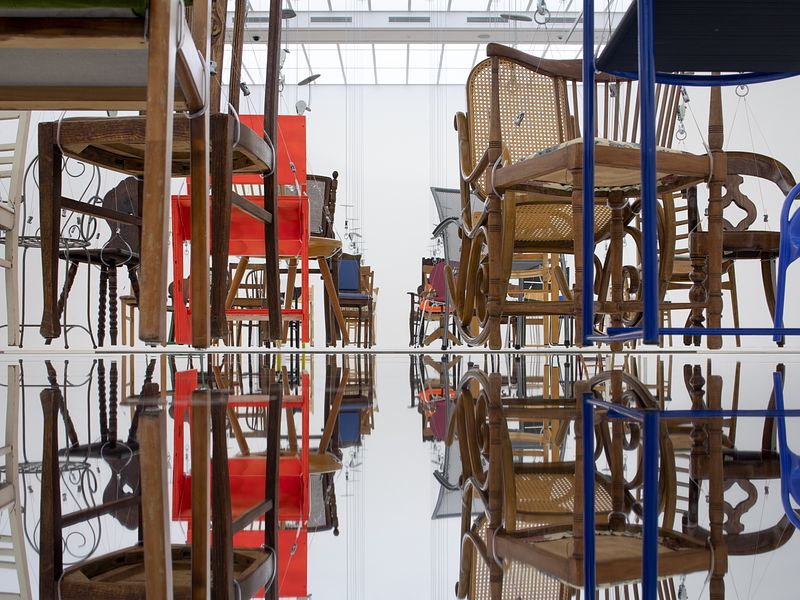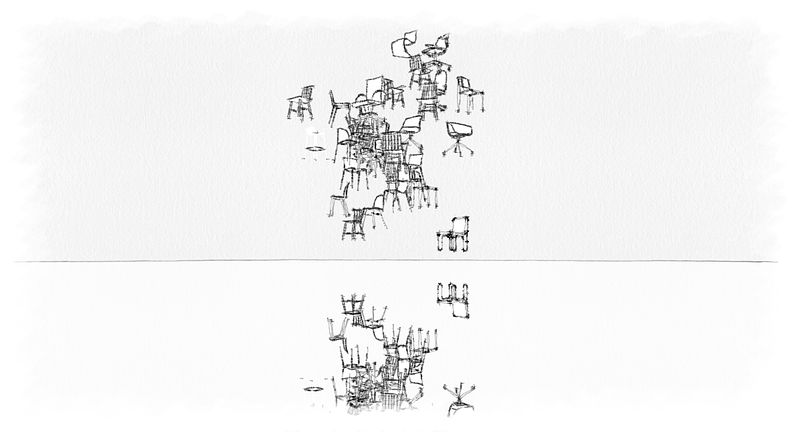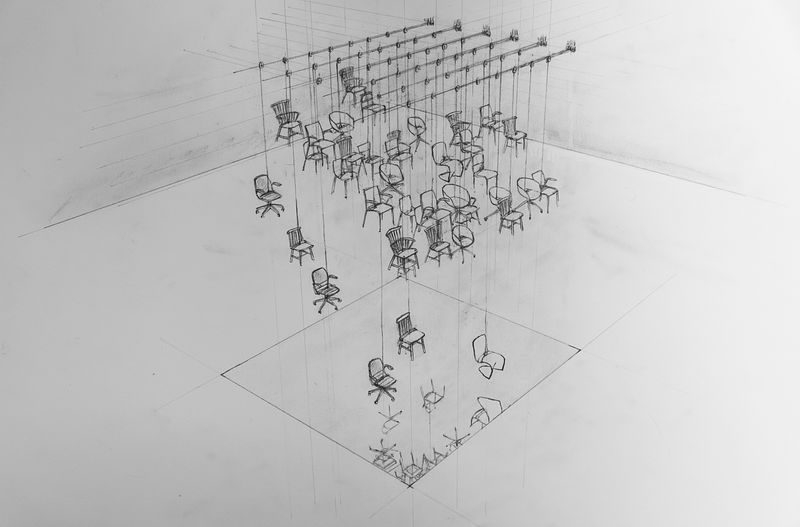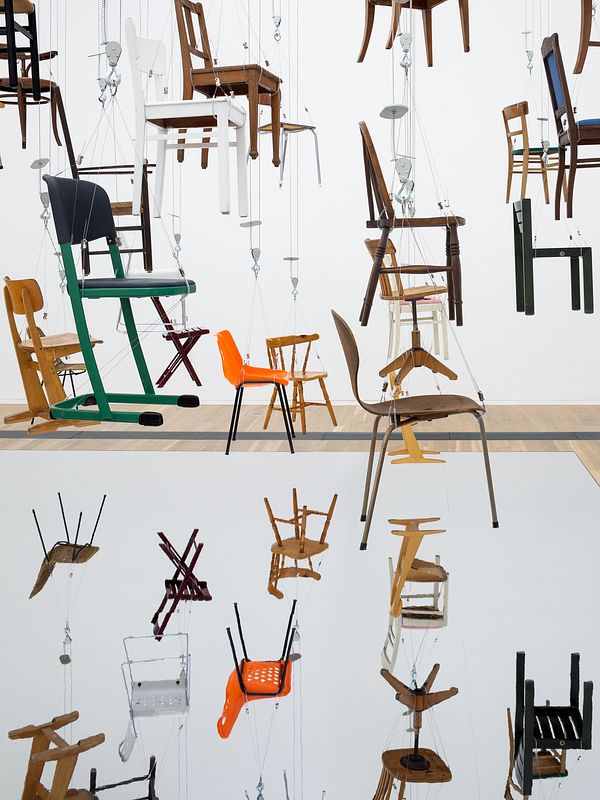13.04.2023
The cycle of things




The cycle of things
by Florian Andrews and Laura Sommer
Art can interrogate society and challenge the status quo. Today’s environmental and climate-change art,(1) which has its origins in the Land Art and Earth Art of the 1960s and 1970s(2) and shares the same concerns, takes up themes such as environmental pollution, the use of land and soils, and the impacts of political decisions. Well-known representatives of this movement then and now include Helen and Newton Harrison, Joseph Beuys, Agnes Denes, Olafur Eliasson, and the art collective Cape Farewell.(3) These artists have had a political agenda, and a wish to effect, through their art, a change in society. To this end, they often choose natural materials, play with the tides, seasons, and natural decay of their artworks, and assign the public an active role.
Joseph Beuys, who was himself a founding member of Germany’s Green Party, went particularly far when it came to public involvement. In Beuys’s understanding, anything that could be molded and shaped to convey a message—including felt, fat, and words—was “material.”(4) This led him to declare as art all everyday activities and all participation in democratic processes that shaped society. With the concept of “social sculpture,” he described the development of our society as a great, ultimate, but never-ending “ecological Gesamtkunstwerk,” to which every citizen could contribute as an artist.(5)
Michael Pinsky’s new work can likewise be considered from the perspective of social sculpture. The involvement of the public in the process is imperative and demands psychological skill, which Pinsky has woven artistically into his work. Within the framework of THE FINAL BID, people supply chairs for which spectators can place bids. Through their bids, the sculpture not only takes on physical shape but also assumes an enhanced significance. The bidders increase the value of the individual chairs and in so doing alter their position in the display. This generates a dynamic movement, which in turn leads to chairs rising to prominence and being seen in a new light. By involving the chairs in the installation, the artist awakens a (fresh) desire for objects that, for various reasons (of fashion or need, for example), are never or rarely used by their owners, or have been kept merely as accessories. This desire brings us to a concept playing a steadily growing role in the contemporary discussion around the ecological and social transformation of our current models of production and consumption: the circular economy.

Installation view THE FINAL BID by Michael Pinsky (2022)
| © Draiflessen Collection, Mettingen/Michael Pinsky, Foto/photo: Henning Rogge
The Economy Discovers Circularity
Grandpa’s armchair or the bench in grandma’s kitchen—many of us may recall such objects when we think back to the seating furnishing the homes of older generations. These items are made special by the fact that they are closely bound up with personal memories and experiences, and with people and families. Should the question then arise of what to do with the armchair or bench when its owner has gone, emotion always plays a part in the answer: if at all possible, they should remain in the family as a reminder of that individual.
Surely what works in the case of objects handed down within families should also be possible elsewhere? Specifically, passing on products and objects for further (or changed) use. That would indeed be good—but it is not the case. Globally speaking, less than 10 percent of all the materials and resources we use, and the products we manufacture,(6) experience a second or third life cycle.(7) That is too little. Especially given that the planet’s resources are finite and that we are repeatedly overshooting the amount the Earth is able to regenerate.(8) Nor, sadly, are these findings new: warnings have been sounded by research, society, and business for more than fifty years.(9) Fifty years—that’s almost two generations of business leaders, scientists, politicians, decision-makers, et cetera, who could have flicked the switch. But that hasn’t happened.
When answering the question of why that is, we quickly come to realize that planning and designing more than a single life cycle for things is not so easy. There are many reasons for this, of which perhaps the most obvious is: Who is actually responsible for recycling an object so that it can embark on a second life cycle? Is it the manufacturer? Or the owner? Or even a third party or institution?
In the case of private cars, for example, the procedure is clear: the owner sells the vehicle either to a dealer or on the used car market. The tasks involved are defined: first offer and sell, then officially transfer ownership and hand over. The same applies to bottles with a deposit on them: empty bottles are either returned to a deposit-refund machine or put outside for curbside collection.(10)
In both instances, not only are there clear rules as to who should take what action and how, but another crucial dimension to the transition to a second life cycle is also present: a financial incentive. Although this incentive may be low in the case of a deposit on a bottle, it is an integral part of everyday life (and often even of daily routine). When it comes to selling a car, the financial incentive is high, but one-off. To put it another way, if the recycling route is not clearly regulated and is not backed up by a financial (or other) benefit, the situation quickly turns into a game of Old Maid: get rid of the responsibility as fast as you can. The result: products and materials that are far too good to throw away end up in garbage cans or gather dust at the back of the garage. Michael Pinsky’s exhibition starts from this point, too. With THE FINAL BID, he creates a particular form of incentive to fetch such objects back out again: through their participation, the chairs can—but do not have to—be elevated to art.
If the Draiflessen Collection can do this, then cannot other stakeholders, such as commerce, economics, politics, and so forth, also do the same? What is the situation in businesses, in the retail trade, in industry, and in the manufacturing and processing sectors? What stimuli are triggering changes in companies in favor of circularity? What is causing the move from a linear to a circular economy? There are three main driving forces, which in practice are not always clearly distinguishable.
Firstly, companies make internal decisions to develop or establish cycles. Often prompted by a mixture of cost considerations and engineering ingenuity, such solutions are frequently characterized by a focus on the company’s own strengths and areas of expertise. The Schoeller paper mill in Osnabrück, for example, invested in closed-loop water cycles as early as the 1970s and 1980s.(11)
Secondly, and this is by no means uncommon, there is an intrinsic motivation to do business in a sustainable manner. With a view to the planet and the related bleak future scenarios, senior management decides that it wants to contribute in its own way toward a world worth living in. The company takes the initiative by itself and only then informs its customers. One example is the Hellmann logistics company, which began measuring CO2 emissions in its transport chain at a very early date. It has now developed a system with which it can calculate the exact CO2 footprint of each shipment, whether a container or an individual consignment, and at least offset these emissions.(12)
The third driver of change comes from outside, in the form of external pressure from the market and consumers, and as a result of new legislation.(13) Pressure from the market means: consumers are demanding more sustainable goods and services. They expect, for example, that products can be repaired—an option that Apple has recently introduced with its Self Service Repair program.(14) The most effective lever for transformation within business, however, remains legislation. And with regard to facilitating the transition to a circular economy, these legislative measures are very extensive. The European Commission is working on a raft of projects to introduce Europe-wide legislation,(15) and numerous initiatives to standardize the field of the circular economy in manufacturing and commerce are underway in Germany and abroad.(16) Companies are thus seeing the arrival, from multiple directions, of requirements that will impact the processes of the linear economy at times very extensively.

Michael Pinsky, The Final Bid (2017/2022), drawing on paper
| © Michael Pinsky, Courtesy the artist, Foto/photo: Michael Pinsky
What Does a Circular Economy Mean for the Economy and for People?
The exhibition THE FINAL BID shows a conventional model of how products and objects (or materials) enter upon a second life cycle: at the end of their first life cycle, chairs are passed on to new households or institutions via an auction or other platforms. Chairs are gratifying products in this context,(17) because they are robust, stable, and easy to use, and because we can usually see immediately what purpose and service we can expect them to fulfill—a desk
chair is plainly not the same as a reading chair. For the exhibition, the chairs were simply spruced up with a duster; they did not need to be refurbished or taken apart and reassembled.
The situation is more complex when it comes to objects or products that cannot be assessed so clearly and whose operation cannot be judged from the outside, as in the case of electrical appliances. Is the item still in good working order? How much life does it have left? And, will my requirements be met if I take over a device, such as a computer, secondhand? To this end, the economy is starting to respond with initiatives and offerings. Common to these is the fact that they answer the question of how to ensure future uses for their products right at the start of the development phase. In other words, at the moment when decisions are made about the design of products and offerings, the focus falls upon what features are necessary for further life cycles.(18) Hand in hand with this goes the question of which business models suit these future-use design features.(19) It is one thing to sell chairs at auction to new owners. Putting technical products into new hands, however, is much more complex and thus a completely different affair. Who is responsible for ensuring that the device is in the best possible condition? When is the right time for this? And if a used computer needs an overhaul or upgrade, who finances this? These are all issues that very quickly lead us to ask whether the current system of supply—demand—purchase—transfer can meet these new demands at all. Do we not need new agreements between manufacturers and buyers?(20) And likewise between businesses? The answer is “yes,” and they are already being discussed.(21)

Michael Pinsky, The Final Bid (2017/2022), drawing on paper
| © Michael Pinsky, Courtesy the artist, Foto/photo: Michael Pinsky
The Circular Society as a Gesamtkunstwerk
If all businesses developed cycles, and if customers accepted these new offerings, would the goal be achieved? Would we then be living in a circular economy? The question arises because companies operate in mutual competition and, to be able to offer circularity, need expertise, processes, and partnerships that in many cases are simply not available. For customers, too, the circular economy will demand more than simply separating their household waste or feeding empty containers into deposit-return machines.
Businesses can rarely implement their cycles single-handedly. Redistribution and reprocessing, for example, are costly: technically difficult and often hard to calculate in financial terms, they are fraught with uncertainties. Where we are currently pursuing a linear economy, therefore, and companies are making decisions driven purely by revenue, we need a new conceptual approach that transcends the bounds of individual companies. This approach must also include consumers, so that the sustained, long-term value of materials and products becomes part of daily life. If we are to achieve a circular economy, we must fundamentally change the way in which we currently produce and consume today. The circular economy requires networks, collaboration, and a priority focus on the value of materials and products.(22) It also has to be appropriately embedded in society, in order to make the actions required as easy and accessible as possible for individual citizens.
The fact that politics can place constraints on citizen engagement is something that Joseph Beuys was obliged to experience firsthand. For his 1982 art installation 7,000 Eichen: Stadtverwaldung statt Stadtverwaltung (7,000 Oak Trees: City Forestation Instead of City Administration), he invited the citizens of Kassel, Germany, to reforest their car-dominated city with 7.000 oak trees, each with a basalt stone erected beside it. He made the trees available for collection in front of the documenta 7 building, with the idea that people would plant them all over the city. Public participation was hampered, however, by Kassel’s bureaucratic regulations, which stipulated where it was permitted to plant trees and where not.(23) The social sculpture of which Beuys dreamed made only halting progress. In the end, the artist did not live to see the completion of 7,000 Eichen; in 1987, his son Wenzel finished the project in his name for documenta 8.
To what extent citizens will participate in THE FINAL BID, and in so doing inject the artwork and its theme with the desired dynamism, remains to be seen. What the circular society, the social sculpture, and THE FINAL BID all have in common, however, is the need for everyone to contribute: the circular society and the social sculpture must be shaped.(24) For without people, there is no movement, no coming together, no attribution of value or value creation—and no art.

Installation view THE FINAL BID by Michael Pinsky (2022)
| © Draiflessen Collection, Mettingen/Michael Pinsky, Foto/photo: Henning Rogge
_____________________________________________________
(1) See Joanna Nurmis, “Visual Climate Change Art 2005–2015: Discourse and Practice,” WIRES: Wiley Interdisciplinary Reviews: Climate Change 7, no. 4 (2016), pp. 501–16; Diego Galafassi et al., “‘Raising the Temperature’: The Arts on a Warming Planet,” Current Opinion in Environmental Sustainability 31 (2018), pp. 71–79.
(1) See Joanna Nurmis, “Visual Climate Change Art 2005–2015: Discourse and Practice,” WIRES: Wiley Interdisciplinary Reviews: Climate Change 7, no. 4 (2016), pp. 501–16; Diego Galafassi et al., “‘Raising the Temperature’: The Arts on a Warming Planet,” Current Opinion in Environmental Sustainability 31 (2018), pp. 71–79.
(2) See Julia Martin, “Ecocritical Art in Times of Climate Change: Tracing Ecological Relationships between Humans and Nonhumans through the Hyperextension of Objects” (PhD diss., Goldsmiths College, London, 2015).
(3) See Ruth Wallen, “Ecological Art: A Call for Visionary Intervention in a Time of Crisis,” Leonardo 45, no. 3 (2012), pp. 234–42.
(4) Joseph Beuys, What Is Art? Conversation with Joseph Beuys, ed. Volker Harlan, trans. Matthew Barton and Shelley Sacks (Forest Row: Clairview Books, 2007).
(5) David Adams, “Joseph Beuys: Pioneer of a Radical Ecology,” Art Journal 51, no. 2 (1992), pp. 26−34.
(6) Circularity Gap Reporting Initiative, The Circularity Gap Report 2022, https://www.circularity-gap.world/ (all URLs accessed in September 2022).
(7) Anna-Maria Leo, “Ein Kompass in Richtung Kreislaufwirtschaft,” Umwelt Perspektiven 2 (2021); Walter Kahlenborn et al., eds., Auf dem Weg zu einer Green Economy: Wie die sozialökologische Transformation gelingen kann, vol. 3 of Neue Ökologie (Bielefeld: transcript Verlag, 2019).
(8) See the Earth Overshoot Day website, https://www.overshootday.org.
(9) Maja Göpel, The Great Mindshift: How a New Economic Paradigm and Sustainability Transformations Go Hand in Hand (Berlin: Springer, 2016); Christophe Bonneuil et al., “Early Warnings and Emerging Accountability: Total’s Responses to Global Warming, 1971–2021,” Global Environmental Change 71 (2021).
1(0) See, for example, Nicolas Bouliane, “The Pfand System: How to Return Bottles in Germany,” All About Berlin, August 26, 2022, https://allaboutberlin.com/guides/pfand-bottles.
(11) See the statements on sustainability by the Felix Schoeller Group on the company website, https://www.felix-schoeller.com/en/responsibility/nature-and-environment.
(12) See the 2021 sustainability report by Hellmann Worldwide Logistics on the company website, https://sustainability-report.hellmann.com/ecology.
(13) Oliver Richters and Andreas Siemoneit, Marktwirtschaft reparieren: Entwurf einer freiheitlichen, gerechten und nachhaltigen Utopie (Munich: Oekom Verlag, 2019).
(14) Apple, “Apple Announces Self Service Repair,” https://www.apple.com/uk/newsroom/2021/11/apple-announces-self-service-repair/.
(15) See, for example, the European Circular Economy Stakeholder Platform, https://circulareconomy.europa.eu/platform/, and the European Commission’s “Circular Economy Action Plan,” https://environment.ec.europa.eu/strategy/circular-economy-action-plan_en.
(16) See, for example, DFGE − Institute for Energy, Ecology and Economy, “ISO Norm for Circular Economy,” https://dfge.de/iso-norm-for-circular-economy/; National Institute of Standards and Technology (NIST), U.S. Department of Commerce, “ISO/TC 323 on Circular Economy,” https://www.nist.gov/el/systems-integration-division-73400/circular-economy-manufacturing/isotc-323-circular-economy; Circular Economy Initiative, “Circular Economy Roadmap for Germany,” May 11, 2021, https://www.circular-economy-initiative.de/circular-economy-roadmap-for-germany.
(17) Tony Curran and Ian D. Williams, “The Role of Furniture and Appliance Re-Use Organisations in England and Wales,” Elsevier: Resources, Conservation and Recycling 54, no. 10 (2010), pp. 692–703.
(18) Richard Buchanan, “Design Research and the New Learning, London Design Council, 1999,” Design Issues 17, no. 4 (2001).
(19) Ralf Reichwald et al., eds., TUM Forum Sustainability: Circular Economy (Munich: TUM.University Press, 2022); United Nations Industrial Development Organization (UNDIO), Circular Economy, https://www.unido.org/sites/default/files/2017-07/Circular_Economy_UNIDO_0.pdf.
(20) Maya Hoveskog and Fawzi Halila, 6th International Conference on New Business Models: New Business Models in a Decade of Action, hosted by Halmstad University, Sweden, held online June 9−11, 2021, www.newbusinessmodels.org.
(21) acatech, Circular Economy Initiative Deutschland, and SYSTEMIQ, eds., Circular Business Models: Overcoming Barriers, Unleashing Potentials, April 29, 2021, https://en.acatech.de/publication/circular-business-models-overcomingbarriers-unleashing-potentials/.
(22) Monika Dittrich et al., Transformationsprozess zum treibhausgasneutralen und ressourcenschonenden Deutschland – GreenLate: Abschlussbericht, ed. Umweltbundesamt (German Environment Agency) (Dessau-Roßlau: Umweltbundesamt, 2020) (CLIMATE CHANGE 02/2020, Ressortforschungsplan des Bundesministerium für Umwelt, Naturschutz und nukleare Sicherheit).
(23) Stefan Körner and Florian Bellin-Harder, “The 7000 Eichen of Joseph Beuys – experiences after twenty-five years,” Journal of Landscape Architecture 4, no. 2 (2009), pp. 6−19.
(24) Dittrich 2020 (see note 22).
This essay, written by Florian Andrews and Laura Sommer, was first published in the magazine accompanying the exhibition THE FINAL BID.